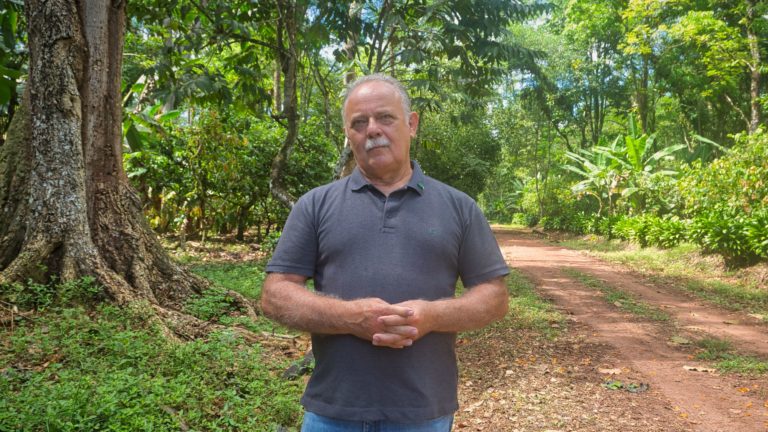- Cacao plantations in the Brazilian state of Pará have helped to recover about 150,000 hectares (370,660 acres) of degraded land in the last 25 years.
- The Brazilian government has supported agroforestry within key commercial crops, such as cacao, to fight rampant deforestation in the Amazon and offset carbon.
- By 2030, another 250,000 cacao trees are expected to be planted in the region, according to some sources, increasing cacao’s currently cultivated area by 25%.
- One hectare of cacao plantation under an agroforestry system can remove 165 tons of carbon from the atmosphere, Brazilian research shows, which could make carbon markets an attractive opportunity for farmers in the Amazon.
Two hours by boat from Belém, the state capital of Pará in Brazil, in the small village of Acará-Açu, wood houses rise on thin piles on the banks of the Acará River. This community has lived for decades on subsistence farming, mostly beans and manioc. Cacao was growing wildly in their gardens, but they didn’t use it commercially.
“It all changed with the arrival of De Mendes,” says Zeno Gemaque, a carpenter-turned-cacao entrepreneur, who is now a supplier for De Mendes, one of Brazil’s artisan chocolate makers that use native cacao. His sister, Luciene, had left the village to find opportunities elsewhere but came back after a few years and opened the first local chocolate factory, run entirely by women.
Brazil is the world’s seventh biggest producer of cacao, with Pará being the country’s top producing state (233,000 tons of cacao produced only in April 2022). Over 90% of the cacao there comes from small and medium-sized family farms that generally grow the bean within agroforestry systems. Using agroforestry helps maintain soil fertility, increases biodiversity and is also lucrative for farmers, as smallholders can earn up to six times more from agroforestry cacao than from cattle ranching. “It [cacao] requires a smaller area to generate an equal amount of profit,” says Adriano Venturieri, researcher at Embrapa, the Brazilian Agricultural Research Corporation.

Agroforestry also supports land restoration. Between 1996 and 2021, about 150,000 hectares (370,660 acres) of degraded land in Pará were restored through agroforestry-based cacao plantations, according to Fernando Mendes, researcher at the Executive Commission for Cacao Cultivation Planning (CEPLAC). By 2030, the state will have cultivated another 250,000 cacao trees, 25% more than the current figure, says Mendes, who has dedicated his career to expanding the plantations. He says cacao represents not just a great economic opportunity, but also an environmental one.
Under agroforestry, cacao could serve as a climate mitigation tool. One hectare of cacao plantation can remove 165 tons of carbon per year, Mendes tells Mongabay. It also can help avoid emissions, as farmers stop using fire to clear their fields between crops, lowering the risk of forest fires and thus keeping greenhouse gases out of the atmosphere. This can help keep emissions at bay as deforestation in the Brazilian Amazon has made the region one of the country’s top carbon emitters.
Offsetting carbon with cacao
Born and raised at a riverside community in the Amazon, Cesar De Mendes has long worked with traditional communities, providing them with technical agricultural knowledge, supporting the production of high-quality cacao, and opening up new markets to trade it. Famous for his chocolate bars, which include native cacao from Indigenous lands in the Amazon, De Mendes spent years researching new ways to improve the lives of local farmers. And according to Luciene in Acará-Açu, De Mendes’ work has improved much more than cacao production. “Now we are not only chocolate producers, we are using cacao as a way to strengthen the community, our identity, our traditions. … To us, women, is also a way toward financial independence.”

The regular visits to communities all around the Amazon have ended up transforming the mission of his company, turning his attention to more sustainable practices, closer to nature. De Mendes’ agroforestry approach is based on scientific research but also on his experiences with forest communities, which have helped him understand how the Amazon is not much of a pristine forest as people generally believe, but rather a complex ecosystem modified by people for thousands of years, with studies also supporting that idea. “Researchers now call it agroforestry, but this is the work that the communities have always done. I believe we can buy their idea, their behavior, and their vision of the universe,” De Mendes tells Mongabay.
But not only the public institutions, like Embrapa and CEPLAC, are promoting the multifaceted role of agroforestry in Pará. The private sector is also endorsing forest protection in Pará, encouraging farmers to harvest and trade from the variety of agroforestry products. “It’s a win-win scenario,” says Valmir Ortega, former state secretary for environment in Pará and the director of Belterra, a company focused on restoring degraded areas. In the case of cacao, Ortega underlines that while keeping the forest, farmers are able to “generate a product of great world potential, chocolate.”

Belterra supports the producers, helping them to increase the crop’s yield and the amount of carbon sequestered by the plantation. This stored carbon acts as a new asset that can be transacted as a carbon credit. The credits can be created from various sources — like reforestation and afforestation projects or agriculture and land management — and different companies worldwide choose different carbon sources to offset their own emissions, thus achieving carbon neutrality.
Carbon trading remains a challenging realm
The global price for carbon emission allowances shows a strong upward trend, with experts expecting a strong expansion in the coming years. Some predict the voluntary carbon market, with $1 billion in transactions in 2021, could be worth up to $180 billion by 2030.
But developing, verifying and certifying a carbon project is part of a complex, expensive and time-consuming process that requires evidence for land rights and involves a lot of bureaucracy. In the Amazon, which holds 40% of the global tropical forests that can serve as carbon sinks, farmers remain unprepared to handle this process. In the Brazilian Amazon in particular, where land rights recognition remains problematic and land conflicts with traditional communities are frequent, this process could prove even harder and make farmers vulnerable, as a lack of information and protection for communities have led to abuses.
According to Fernando Mendes, carbon speculators acting as middlemen for companies in search of quick profits are asking cacao producers in Pará to sign suspicious contracts for the carbon within their lands. These contracts can range from “one page [to] five pages [to] 20 pages long,” says Mendes, who welcomes carbon offsets as another ecosystem service provided, thanks to farmers making sustainable choices.

The concern, he explains, is the lack of information on this subject, as the majority of producers are not educated enough to understand the complexity of the carbon market, let alone to fully grasp what the carbon inside the cacao refers to. And, as the Amazon has witnessed over the centuries, “the more a business is unknown, the more people can profit from it,” Mendes tells Mongabay.
Various cases of rural communities in the Amazon being exploited by carbon speculators have been reported. Across the Global South, similar abuses have been reported involving communities and companies in Australia, Mozambique, China, Papua New Guinea, and other parts of South-East Asia.
On the other side of the Atlantic Ocean, sitting in his London office, Divaldo Rezende is the chairman of the Social Carbon Foundation. Considered a pioneer in the carbon industry, he was the first to develop a carbon project in Brazil, at Bananal Island, in his home state of Tocantins. He supports agroforestry cacao production in the Amazon for its local economic benefits to the communities, adding that such a nature-friendly agricultural model also works as a soft sell, as it “contributes to establishing the ‘Amazon Cacao’ brand, which people here in London are very open to.”
But, as any new industry, there are issues that still need to be solved. Rezende points to unwanted approaches such as companies producing contracts restricting farmers’ rights and offering corporations easier ways to profit from the carbon offsets supplied by the farms.
Making carbon trading more easily navigable for the people on the ground who help to offset emissions is still a work in progress. New regulations for voluntary carbon markets were expected to be announced by world leaders in November at COP27, but discussions around key issues were postponed, leaving technical details around accounting and trading still unclear. Mateusz Ciasnocha, a Polish researcher and farmer, part of the grassroots organization “European Carbon Farmers,” recently told the UN Development Program that “it is critical to bridge these different narratives, different words, different levels of governance and policymaking into one that is consistent, coherent and understood by the farmer.”

For cacao farmers in Acará-Açu, trading carbon offsets is not a tangible idea. Cesar De Mendes is enthusiastic with the arrival of the carbon industry. “I know it’s a new concept, it can benefit the communities and help to preserve the forest … but I’m not very familiar with it,” says De Mendes. For Luciene and Zeno, their land, the river and the forest are all part of the path toward an ecological balance. But carbon in particular remains, according to Luciene, “a distant concept to our reality.”

Citations:
Levis, C., Costa, F. R., Bongers, F., Peña-Claros, M., Clement, C. R., Junqueira, A. B., … Ter Steege, H. (2017). Persistent effects of pre-Columbian plant domestication on Amazonian forest composition. Science, 355(6328). doi:10.1126/science.aan8837
UN Food and Agriculture Organization. (2020). The State of the World’s Forests. Retrieved from https://www.fao.org/3/ca8642en/ca8642en.pdf
Banner image: Cacao grown under agroforestry in Pará, Brazil, offers farmers more sustainable livelihoods. Image by Miguel Pinheiro.
Other relevant reading:
For Costa Rica’s Indigenous Bribri women, agroforestry is an act of resistance and resilience
To save chocolate’s future, ‘start now and go big’ on agroforestry
Agroforestry and land reform give Brazil cacao farmers sweet taste of success
FEEDBACK: Use this form to send a message to the author of this post. If you want to post a public comment, you can do that at the bottom of the page.
